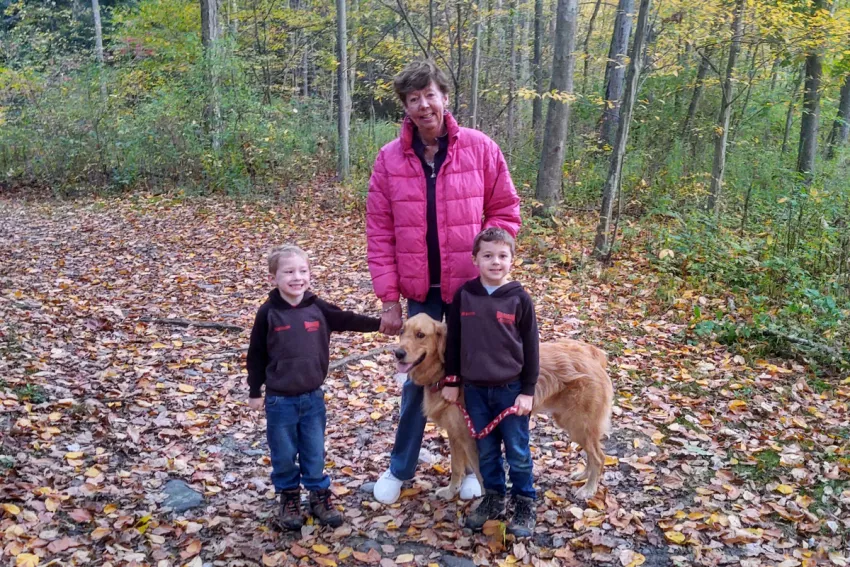Photo above: After two minimally invasive surgeries to repair multiple aortic aneurysms, Jawan Betts recovered quickly and enjoys spending time outdoors with her grandsons Weston (right) and Charleson.
Jawan Betts likes to save time by booking multiple medical appointments on the same day. But in the autumn of 2017, her usual plan went awry when two of her doctors heard a new heart murmur. Instead of going home on time, she went for an ultrasound and a CT scan at her community hospital in upstate New York. The results revealed she had two aortic aneurysms.
“I was so scared that day,” said Betts, who was 59 at the time and working full-time as a supervisor in a medical practice. “I knew it meant that they’d have to open me up, all the way down. And that did not appeal to me one bit.”
Patient wants wait-and-see approach
The doctors at her local community hospital sent her to the University of Rochester Medical Center, where vascular surgeon Michael Stoner, MD, told her endovascular surgery for a situation as complex as hers would be coming to Rochester soon, and in the meantime, she might be a good candidate for a study he was working on.
Betts was fine with waiting and monitoring the aneurysms. She didn’t have any symptoms.
“It was easy to ignore it for a while,” she said. “In hindsight, I know it wasn’t a smart thing to do, given the risks, but I was in denial for a long time. You really don’t know how you’ll react to something like this.”
Eighteen months later, she learned she didn’t qualify for the study after all. And a third aneurysm had developed. Stoner referred her to Andres Schanzer, MD, FACS, Chief, Division of Vascular and Endovascular Surgery, Director, Center for Complex Aortic Disease at UMass Memorial Medical Center, Director, UMass Memorial Health Heart and Vascular Center, and Professor, UMass Chan Medical School.
She drove the six hours from her home outside Rochester to Worcester to find out whether she would be a good candidate for the minimally invasive endovascular aortic repair (EVAR). She was impressed by Schanzer, but she didn’t feel ready to have the surgery.
“It’s terrifying when your doctor tells you that you have a life-threatening condition, and it’s terrifying to think of having such a complex surgery,” said Devon Robichaud, MSN, ACNP, Clinical Coordinator for the Center for Complex Aortic Disease. “Sometimes it takes patients a while to come to terms with it. If their aneurysms aren’t yet very large, they can take some time, but the risk increases as time goes by and the aneurysms grow.”
Ready to defuse ‘ticking time bomb’
For a while, Betts was satisfied with having the aneurysms monitored, but over time, she recognized the danger of not repairing them. She scheduled two endovascular surgeries with Schanzer, both in 2020.
“I was something of a ticking time bomb,” Betts said. She had a Type 2 thoracoabdominal aortic aneurysm that measured more than 6 centimeters. This is the most extensive type of aneurysm, as it involves the majority of the thoracic aorta and abdominal aorta.
“Devon was my shining star. She held my hand from my first appointment through my recovery. We still keep in touch.”
The first surgery was Tuesday, February 4, 2020, when COVID-19 was “just a little rumble,” Betts said. “The surgery itself was a breeze. I woke up with no pain at all and spent the night in the step-down unit. The care was phenomenal. I went home the next day and went back to work on Monday.”
Fear of pandemic, not surgeries
The second surgery was more complex, but Betts’s fear about returning to the hospital was due to the pandemic rather than the procedure.
“Around March 17, the world basically had to shut down. I was physically sick from the stress. I thought, ‘Am I crazy to walk into a hospital in this situation?’ I asked my PCP for advice, and she made me realize it was life or death. I chose life. Once I made up my mind, there was no going back.”
On March 23, there was so little traffic that they made it to Worcester in record time. Her husband and son dropped her off at the hospital entrance, which was eerily quiet. She was one of only a few patients in the waiting room, which had been crowded with dozens of people the month before.
“Jawan’s surgery was the first we had scheduled since the shutdown,” Robichaud said. “COVID was causing so much uncertainty and fear at that time. Very few surgeries were taking place anywhere in the hospital.”
Home three days after more complex surgery
The surgery went exactly as planned, and although Schanzer had told Betts to expect to spend five to eight days at the hospital, she was well enough to go home after three.
“I was almost disappointed,” Betts said. “I kind of liked having the call button, and the nurses were amazing.”
Her recovery was smooth and rapid.
“On day 13 after the surgery, I woke up to a beautiful sunny day,” she said. “I drove myself to the area where we like to camp and went on a little hike. I felt great.”
‘A gift’ to have this surgical option
Betts, now 64, is followed by Stoner close to home, and Schanzer and his team review her annual CT scan to ensure the stents are all working as expected.
“It was a gift that Dr. Schanzer was doing this type of surgery,” Betts said. “It was exactly what I needed, and I got there at exactly the right time — in spite of COVID.”
View more stories of healing, advancing medicine and innovating from UMass Memorial Health.


